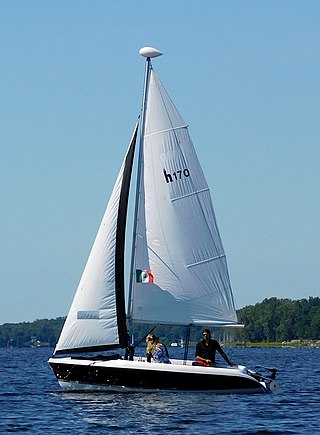
The Melges 32 is an American sailboat that was designed by Reichel/Pugh as a one-design racer and first built in 2004.

The Phantom is a British sailing dinghy that was designed by Paul Wright and Brian Taylor as a one-design racer and first built in 1971.

The Farrier F-22 is a New Zealand trailerable trimaran sailboat that was designed by Ian Farrier and first built in 2014.
The Swan 54 is a Finnish sailboat that was designed by Germán Frers as a blue water cruiser and first built in 2015. The interior was designed by Heini Gustafsson.

The DS-22 is a Canadian trailerable sailboat, that was designed by Bruce Kirby and first built in 1983.

The DS-16 is a Canadian trailerable sailboat, that was designed by G. Diller and Herman Schwill and first built in 1970.

The Paceship PY 23 is a Canadian trailerable sailboat, that was designed by John Deknatel of C. Raymond Hunt Associates and first built in 1973.

The Mariner 19 is an American trailerable sailboat, that was designed by Philip Rhodes and first built in 1962.

The Hunter 170 is an American sailing dinghy that was designed the Hunter Design Team and first built in 1999.
The Hunter 212 is an American trailerable sailboat that was designed by Chuck Burns as a day sailer and cruiser and first built in 1996.
The Hunter 240 is an American trailerable sailboat that was designed by the Hunter Design Team and first built in 1998.

The Beneteau First 26 is a French sailboat that was designed by Jean-Marie Finot of Groupe Finot as a cruiser-racer and first built in 1984.

The Hobie Wave is an American catamaran that was designed by Morrelli & Melvin and first built in 1994.
The Cornish Crabber 17, or just Cornish Crabber, is a British trailerable sailboat that was designed by Roger Dongray as a daysailer and pocket cruiser and first built in 1989.
The Eolia 25 is a French trailerable sailboat that was designed by Philippe Briand as a coastal cruiser and first built in 1983.
The Herreshoff Goldeneye is an American trailerable sailboat, designed as a day sailer and cruiser and first built in 1959. The hull lines were designed by Nathanael Greene Herreshoff and the rig by A. Sidney DeWolf Herreshoff.

The Houdini is a New Zealand sailing dinghy that was designed by John Welsford as a cruiser and first built in 2011.
The Jeanneau Flirt is a French trailerable sailboat that was designed by the Jeanneau Design Office, as a pocket cruiser and first built in 1976.
The Sun Way 21 is a French sailboat that was designed by J&J Design as a cruiser and first built in 1989.
The Beneteau First 20 is a French trailerable sailboat that was designed by Finot/Conq as a cruiser-racer and first built in 2011.











